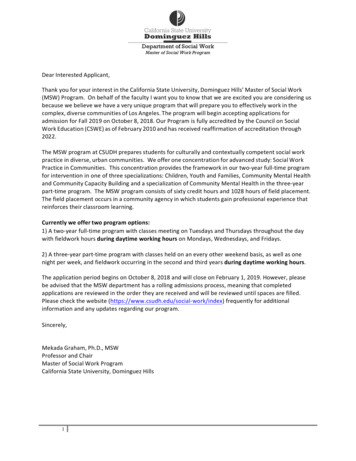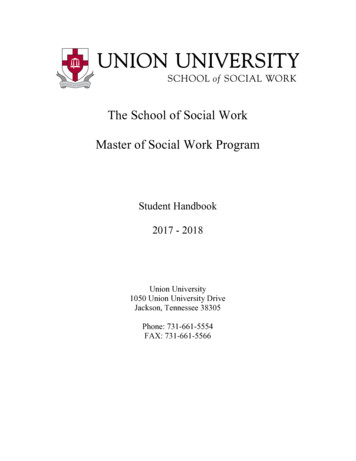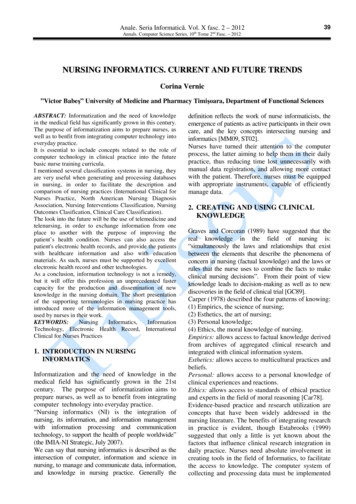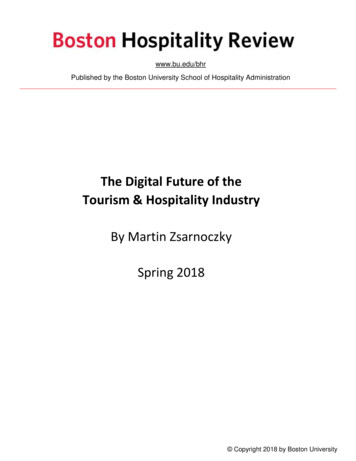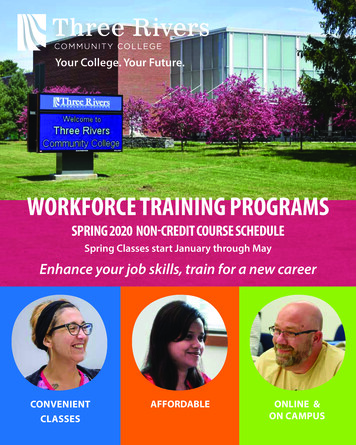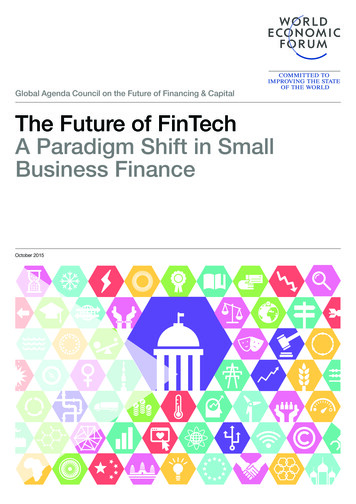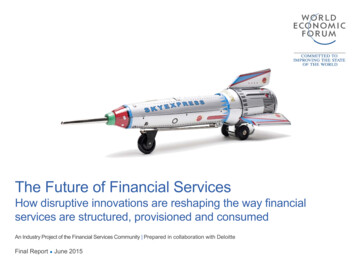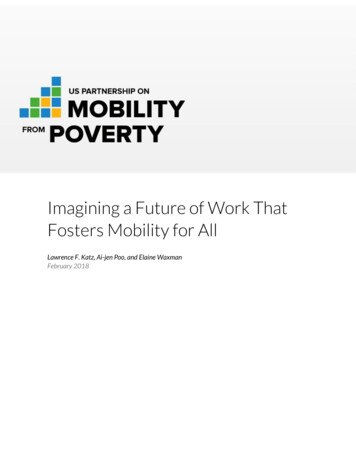
Transcription
Imagining a Future of Work ThatFosters Mobility for AllLawrence F. Katz, Ai-jen Poo, and Elaine WaxmanFebruary 2018
The ideas in this paper were shaped by discussions within the Partnership but do not necessarily represent theviews of all members.The authors would like to thank Greg Acs, Nisha Patel, David Ellwood, Matt Rogers, Vanessa Fernandez, and MeganThompson, who reviewed and provided feedback on drafts. We held two design labs with a wide variety of experts,and these sessions were extremely valuable in informing our thinking. Participants in the subsidized jobs and futureof works design labs were generous with their time, energy, and expertise during a daylong discussion. Thesubsidized jobs design lab participants were Gordon Berlin, Marianne Bertrand, Dan Bloom, Gerald Chertavian,Sharon Coenis, Mary Coleman, Indivar Dutta-Gupta, David Ellwood, Roland Fryer, Jason Furman, Carla Javits,Sendhil Mullainathan, Nisha Patel, LaDonna Pavetti, Ryan Rippel, Ken Troske, and Melissa Young. The future ofwork design lab participants were David Autor, Myrla Baldonado, Sharon Block, Margot Brandenburg, DavidEllwood, Althea Erickson, Nancy Folbre, Natalie Foster, Wilma Liebman, Michelle Miller, Jose Oliva, EmmaOppenheim, Quentin Palfrey, Sharon Parrott, Nisha Patel, Ryan Rippel, Carmen Rojas, David Rolf, Cecilia Rouse,Palak Shah, Kristin Sharp, Saket Soni, Shayna Strom, Peter Tillman, Zeynep Ton, Anna Wadia, and Dorian Warren.We would also like to thank Quentin Palfrey, Jack Reimer, Steven Ryan, and Pauline Shoemaker from J-PAL NorthAmerica, who helped organize, coordinate, and host the subsidized jobs design lab. Responsibility for any errors lieswith the authors alone.ABOUT THE US PARTNERSHIP ON MOBILITY FROM POVERTYWith funding from the Bill & Melinda Gates Foundation, the Urban Institute is supporting the US Partnership onMobility from Poverty. Led by chair David Ellwood and executive director Nisha Patel, the Partnership consists of24 leading voices representing academia, practice, the faith community, philanthropy, and the private sector.The Partnership’s definition of mobility has three core principles: economic success, power and autonomy, andbeing valued in community. Our collective aspiration is that all people achieve a reasonable standard of living withthe dignity that comes from having power over their lives and being engaged in and valued by their community.
ContentsExecutive SummaryivThe Problem: Modern Employment Practices Are Failing Too Many Workers1Trend 1: Decline in Access to Jobs That Provide Good Wages, Benefits, and Opportunitiesfor Many Workers2Trend 2: Increase in Alternative Work Arrangements with Fewer Protections4Trend 3: Decline in Jobs Covered by Collective Bargaining6Trend 4: Increased Reliance on Automation, Including Artificial Intelligence6Trend 5: Declining Connection to the Labor Market for Some Workers6The Diverse Ways Work Matters for ProsperityThe Solutions: Promising Strategies for Increasing Workers’ Rights, Protections,and Opportunities810Strategy 1: Facilitate Access to Work That Pays Well10Strategy 2: Create Portable Benefits for Workers in Alternative Employment Arrangements13Strategy 3: Strengthen Workers’ Roles in Shaping Their Future14Strategy 4: Leverage Wage Subsidies and Job Guarantees for America’s Most Vulnerable Workers15Strategy 5: Invest in a Multifaceted Strategy to Improve Specific Growth Sectors, Such as Care Work 17Strategy 6: Build Human Capital over a LifetimeOur Proposal1719Critical Reform 1: Establish a New Approach to Worker Classification That ExtendsBasic Protections to All WorkersCritical Reform 2: Pilot and Scale Models for Portable Benefits1920Critical Reform 3: Invest in Building Capacity for Workers to Have a Strong Voice in Their Future,Including Alliances across Sectors and with Consumers and “High-Road” Employers21Critical Reform 4: Establish a Subsidized Jobs and Job Guarantee Pilot with Longer-TermInvestments in Subsidies22Critical Reform 5: Enhance the Earned Income Tax Credit for All Workers, EspeciallyAdults without Dependents25Critical Reform 6: Support a Multifaceted Strategy for Improving Jobs and Capacityin the Care Sector25Moving the Vision Forward27Appendix A. Expanding the Earned Income Tax Credit29Appendix B. Codes of Conduct40Notes41
Executive SummaryOne of the important things about having a large middle class for society is that there’s a sense ofeveryone being part of the shared project . When the middle class starts to crumble, peopleincreasingly see themselves as different from others. They sort themselves by wealth, byeducation level, and the result is that there’s an increasing fracturing of society, a loss of thesolidarity that comes with having a large middle class. And that can be very destructive to arepublic, because part of what makes our system work well is that we have a shared sense of whowe are as a people, and that we see each other as part of a shared project that’s called America.—legal scholar Ganesh Sitaraman 1The Problem: Modern Employment Practices Are FailingToo Many WorkersWe live in a time of rising economic polarization. Low- and high-wage jobs are growing, while those in themiddle are declining or “hollowing out,” not just in the United States, but across the globe. 2 Employmentused to be a reliable path to economic stability and mobility for a wide range of workers, but that is nolonger the case. In 2015, almost a quarter of working Americans earned poverty-level wages, 3 defined asequal to or less than the hourly wage that a full-time, year-round worker must earn to sustain a family offour with two children at the official poverty threshold. Workers are confronting rapid labor marketchanges that are eroding key features of work once largely taken for granted. Five trends are shapingeconomic opportunity:1.Decline in access to jobs that provide good wages, benefits, and opportunities for many workers2.Increase in alternative work arrangements with fewer protections3.Decline in jobs covered by collective bargaining4.Increased reliance on automation, including artificial intelligence5.Declining connection to the labor market for some workersThe Diverse Ways Work Matters for ProsperityMost American households rely on labor market earnings as their primary source of income. Employmentalso leads to benefits beyond wages and salaries, including access to health insurance, retirement benefits,IVEXECUTIVE SUMMARY
and sources of income when injuries occur and when work is not available, such as workers compensationand unemployment insurance. Work can also be a mechanism for obtaining additional skills (both “hard” and“soft”) that increase human capital and facilitate upward mobility, act as a point of connection with thebroader community (i.e., social capital), and provide roles and responsibilities that contribute both structureand meaning to a person’s life. Work’s dignity-enhancing benefits spill over into positive benefits for one’schildren and the larger community.The Solutions: Promising Strategies for Increasing Workers’Rights, Protections, and OpportunitiesThe changing nature of work presents complex economic and social challenges that affect all workers. Nosingle policy lever or private-sector innovation can address the challenges of improving economic securityand mobility in a rapidly evolving 21st century economy. Instead, we can look to and learn from severalpromising strategies that can serve as building blocks for a more inclusive economy.1.Facilitate access to work that pays well2.Create portable benefits for workers in alternative employment arrangements3.Strengthen workers’ roles in shaping their future4.Leverage wage subsidies and job guarantees for America’s most vulnerable workers5.Invest in a multifaceted strategy to improve specific growth sectors, such as care work6.Build human capital over a lifetimeOur ProposalWe envision a future in which every person contributing to our economy has the economic security thatemployment in America should confer. To realize that vision, we need investments that will develop,evaluate, refine, and scale key policies and practices central to improving the future of work in anincreasingly fragmented environment. Specifically, we recommend investments that support six criticalreforms:1.Establish a new approach to worker classification that extends basic protections to all workers.2.Pilot and scale models for portable benefits.3.Invest in building capacity for workers to have a strong voice in their future, including alliancesacross sectors and with consumers and “high-road” employers.4.Establish a subsidized jobs and job guarantee pilot with longer-term investments in wage subsidies.EXECUTIVE SUMMARYV
5.Expand the earned income tax credit to help make work pay for all workers, including adultswithout dependent children.6.Support a multifaceted strategy for improving jobs and capacity in the care sector.Moving the Vision ForwardThe rapidly evolving 21st century economy requires a significant investment in reimagining those policies,institutions, and norms that govern work and the work-related safety net in the United States. Philanthropycan catalyze innovation in several key ways. Government is an essential partner in fostering economicmobility, and the rapidly changing nature of work requires policymakers to innovate alongside employersand workers. Government at all levels has a stake in labor market innovations. State and local governments,in particular, may be good potential partners for advancing new strategies. And workers themselves, inaddition to employers, must have a strong voice in shaping the future.Impact on Three Dimensions of MobilityThe Partnership’s definition of mobility has three core principles: economic success, power and autonomy,and being valued in community.Investment: The cost of the six investments we propose to improve pay, job quality, and worker skills willvary depending on the scale and scope, and several of these ideas represent learning opportunities inadvance of a full-scale policy, program, or legal change.Impact: Economic Success: Improved labor market institutions and worker skills will pay off in higher rates ofemployment and earnings, access to more comprehensive benefits, and lower material hardship. Power and Autonomy: Workers will have strong voice in shaping the future of their workplaces.Extending basic workplace protections to all workers and supporting worker engagement in keyemployment policies, such as scheduling, pay and benefits, will equip workers with concrete tools forinfluencing the changing world of work. We also expect workers to report higher levels of self-efficacy,a stronger sense of control, and higher levels of mastery and autonomy. Being Valued in Community: We expect workers to report greater levels of belonging and have higherperceived standing in the community and society.VIEXECUTIVE SUMMARY
The Problem: Modern EmploymentPractices Are Failing Too Many WorkersWe live in a time of rising economic polarization. Low- and high-wage jobs are growing, while those in themiddle have lagged, not just in the United States, but across the globe. 4 Employment used to be a reliablepath to economic stability and mobility for a wide range of workers, but that is no longer the case. In 2015,almost a quarter of working Americans earned poverty-level wages, 5 defined as equal to or less than thehourly wage that a full-time, year-round worker must earn to sustain a family of four with two children atthe official poverty threshold. Many workers are confronting rapid labor market changes eroding keyfeatures of economic security associated with work once largely taken for granted, including basic legal protections for workers; access to opportunities for advancement and nonwage benefits that reduce expenses and bufferinstability (e.g., health insurance, workers compensation, unemployment insurance, life or disabilityinsurance, and family leave benefits); and opportunities for workers to advocate collectively for their interests.The primary mechanisms for organizing and delivering these protections and benefits largely emergedduring the mid-20th century industrial era. Such mechanisms were rooted in the idea that a worker washired and supervised by a single employer and that staying on the job brought access to a career ladder, or atleast a package of wages and benefits that provided stable income for workers with even limited formaleducation. Key legal protections were defined by this idea of work, and many workers could also count on aunion to advocate for better benefits and workplace conditions. Increasingly, however, that underlyingconception of the employment relationship no longer holds. As a result, a significant proportion of the USlabor force faces increased exposure to workplace and social risks rooted in the emergence of the “fissuredworkplace,” in which many traditional employers have shed responsibility for workers throughsubcontracting or hiring independent contractors. Significant competition among smaller organizations forrelationships with these leading, large companies contributes to downward pressure on wages and benefits,introduces uncertainty over responsibility for work conditions, and creates a more fragmented environmentin which labor violations can occur. 6The persistent problems of low wages and limitations in workplace protections have also becomesalient for a growing number of workers as the demand for certain types of jobs in the US economy shiftsbecause of larger societal changes. The increased engagement of women in the labor force and the aging ofthe population means that demand for certain types of domestic care work, such as child care and home care
for older adults, has grown. Domestic workers were excluded from key components of the employmentbased social contract that has shaped opportunity for many Americans, such as the New Deal–era NationalLabor Relations Act, which provides for collective bargaining, and the Fair Labor Standards Act of 1938,which governs laws providing minimum wage, overtime pay, and other protections. Although subsequentamendments to the latter expanded protections for domestic workers, exemptions remain, such as forcompanions for older adults, and these jobs continue to be associated with low wages, few benefits, andpoor treatment. And because these jobs have been held primarily by women and many women of color, bothpolicy choices and systemic gender bias and racism have contributed to cumulative economic disadvantage.More broadly, much recent job growth in the US economy has come from various jobs classified asindependent contractors or other types of contingent and alternative work arrangements, which may beexcluded from the National Labor Relations Act and Fair Labor Standards Act. While these significantchanges in the US economy are well documented elsewhere, we briefly highlight key trends here as theyprovide context for the ideas we explore in this paper. In box 1, we highlight what work looks like in onerapidly expanding but highly vulnerable area of employment: the care sector.Trend 1: Decline in Access to Jobs That Provide GoodWages, Benefits, and Opportunities for Many WorkersThere has been a decline in jobs that provide good wages, benefits, and work-based opportunities forworkers who have less education. Workers are increasingly segregated across employers by education, withgreater economic returns to workplaces where workers with more education and skill are concentrated. 7Job growth has been concentrated in higher-wage industries, as well as in sectors that rely more heavily onlesser-skilled workers and are characterized by persistently low wages and a greater likelihood of irregularwork schedules. 8 Opportunities for progression within employers have been eroded with the shift ofresponsibility for many workers to smaller, highly competitive subcontractors and the decline in the numberof jobs covered by union bargaining.2IMAGINING A FUTURE OF WORK THAT FOSTERS MOBILITY FOR ALL
BOX 1High Growth in Low-Quality Jobs: The Care SectorWorkers who are significantly vulnerable—in wages, benefits, legal protections, and voice—are often concentrated in certainsegments of the labor market, especially lower-skilled occupations in the service sector.a Service occupations have been an areaof significant recent job growth for lower-skilled workers. Certain sectors, like care work, particularly home-based elder care, areexpected to be the source of rapidly expanding employment in the coming decade and beyond. The care sector also representssignificant challenges for improving the quality of work. Historically, domestic work, including home-based care work, wasexcluded from basic protections, such as the Fair Labor Standards Act and the National Labor Relations Act. Further, thedispersed nature of this sector has represented significant barriers to raising and enforcing standards, establishing norms, andorganizing workers to advocate for better conditions. Although formal education requirements for care jobs are low, they dorequire skills that often go unrecognized and are poorly rewarded in the formal economy. In many ways, the care sector offers animportant laboratory for how lower-skilled jobs that are likely to continue being in demand could be improved.While care work has not been formally defined, it typically includes personal assistance and health support to older peopleand those with disabilities, as well as child care. Although wages and job quality are also a concern among paraprofessionalworkers in institutional settings like nursing homes, the most vulnerable jobs are typically in the home care setting, where theworkforce is widely dispersed, is less likely to work full time, and has fewer employment-based benefits.b The home careworkforce focused on the elderly and disabled has doubled over the past 10 years, as health care services and long-term caresupports have shifted from institutions to the community and as people live longer and the number of people older than 65continues to grow. Home care occupations are projected to add more jobs to the economy than any other occupation between2014 and 2024.cAdvocates argue that poor job quality is a factor in the persistent shortages in the home care workforce. Hourly wages arelow and have been largely stagnant, and work may not be consistently full time. As a result, average annual earnings areapproximately 13,800. A quarter of home care workers are estimated to live in poverty, and more than half require publicassistance.d Because work typically takes place in individual homes, workers are isolated and may be subject to harassment andlabor violations with little recourse.The National Domestic Workers Alliance was founded in 2007 to elevate the role of care workers and all domestic workers,improve wages and access to benefits, secure basic worker protections, and improve job quality. To deal with continuedlimitations in some federal regulatory protections, the alliance helped enact a regulatory change at the Department of Labor thatbrought nearly 2 million home care workers who had previously faced exclusion under wage protections and sought passage ofthe Domestic Workers Bill of Rights in state legislatures; as of late 2017, eight states have implemented new laws and othershave bills under consideration. The focus of state statutes typically includes protection against discrimination and harassment,overtime and some paid leave, and, in some cases, easier access to workers compensation.aDavid H. Autor and David Dorn, “The Growth of Low-Skill Service Jobs and the Polarization of the US Labor Market,” American Economic Review103, no. 5 (2013): 1553–97; Ai-jen Poo and Carol Whitlatch, “Caregiving in America: Supporting Families, Strengthening the Workforce,”Generations, Journal of the American Society on Aging 40, no. 4 (2017): 87–93.bInstitute for the Future of Aging Se
Jul 19, 2016 · Lawrence F. Katz, Ai-jen Poo, and Elaine Waxman . . 24 leading voices representing academia, practice, the faith communi ty, philanthropy, and the private sector. The Partnership’s definition of mobility has three core principles: economic success, power and autonomy, and .

